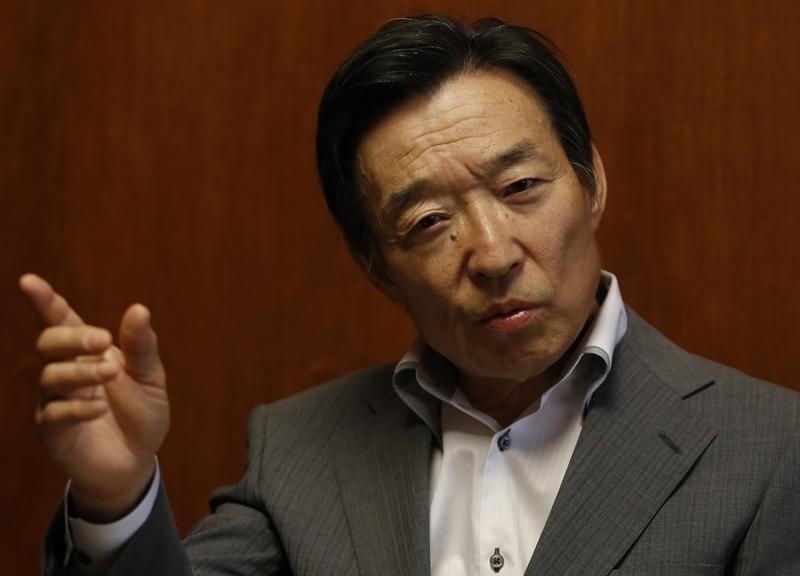By Leika Kihara
TOKYO (Reuters) - The Bank of Japan is caught in a bind, nearly two years into its stimulus experiment, as it further qualifies its inflation goals in response to tumbling oil prices, a move that could prove self-defeating by tempering price expectations.
In April 2013, the BOJ pledged to achieve its 2 percent inflation target in "about two years" under Governor Haruhiko Kuroda's monetary easing policy, a campaign to print money at an unprecedented scale in Japan.
The bold, simple pronouncement with a clear time-frame drove down the yen and boosted stocks, reinforcing the initial impact of the easing programme, which is aimed at lifting Japan clear from two decades of crippling deflation.
Though the timeframe remains official policy, in practice it has been slipping over the horizon, and now officials are adding another layer of atmospheric haze with a more convoluted assessment of what kind of inflation they are measuring.
The shifting of goalposts is a recognition that several factors, most recently the collapsing price of oil, are pulling inflation away from the BOJ's target, forcing it to keep adding footnotes to complicate - and some would say obscure - what had been a simple, clear policy commitment.
After all, two years have nearly passed, and core consumer inflation, the BOJ's key price gauge, is only a quarter of the bank's target, and is expected to slow further in the coming months.
In the first year of the easing campaign, known as QQE, the presentation panels Kuroda used in public appearances marked in bold the magic number "2", to demonstrate his determination to hit the two-year, 2 percent target and nudge people into spending.
"QQE aims to show the BOJ's strong, clear commitment to end deflation to wipe out people's deflationary mindset," Kuroda told a speech in September 2013. "We therefore ... set a clear deadline to hit the target, which is roughly two years."
A year later, in the face of a weakening economy, the BOJ fudged the time goal to "around fiscal 2015", which effectively opened the window to at least March 2016.
Kuroda stopped mentioning the two-year timeframe in public from around September last year, when oil price falls were in full swing.
CLARITY VERSUS FLEXIBILITY
The simple became yet more complex when the BOJ expanded QQE in October, blaming oil for slowing inflation, only to stand pat in January when oil prices kept falling.
With many in the board strongly against further easing, the BOJ is quietly laying the ground to justify holding pat even as inflation is seen grinding to a halt in the coming months. Its new communication strategy is to stick to its timeframe, but make it as ambiguous as possible, analysts say.
BOJ officials concede that depending on oil moves, Japan may not see inflation hit 2 percent until the middle of next year, or even later.
"Nobody could predict oil prices would fall so much," said one source on condition of anonymity. "I doubt the BOJ will come under fire for failing to hit the target strictly in two years."
Deputy Governor Kikuo Iwata, who was once a strong advocate of the timeframe, said on Wednesday it would take longer than he expected for Japan to hit 2 percent.
But officials are also beginning to stress that they do not look just at core CPI but a broad range of price indicators including core-core CPI, which strips out the effect of energy costs.
The BOJ, which never disclosed the market estimates on which it bases its inflation forecasts, also said in January that oil price falls would push down inflation by 0.7 percentage point.
Some analysts say it is an attempt by the BOJ to argue that it is on track to hit the price target because when excluding the effect of oil, core consumer inflation will hit 1.7 percent next fiscal year, close to its 2 percent target.
"What's important is to look not just at price moves of individual goods, but at the medium- and long-term trend of prices," Kuroda told parliament last week.
Last month Kuroda said the timing for meeting his target may stretch into fiscal 2016.
"Our board never said we will hit 2 percent inflation strictly in two years," he told parliament last week.
The BOJ's struggle underlines the challenge central banks face in balancing clear communication and policy flexibility, and how to affect psychology with its stimulus.
Surveys of Japanese households and corporate inflation expectations show they have barely heightened since QQE was put in place. A market measurement of inflation expectations has also fallen, to the dismay of the BOJ.
Hideo Kumano, a former BOJ official who is now chief economist at Dai-ichi Life Research Institute, believes the BOJ will eventually have to reconsider its two-year timeframe.

"In real life, unpredictable things happen. It's unrealistic for policymakers to persist on too rigid a timeframe," he said.